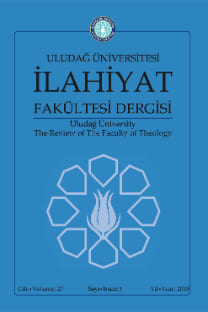Tasavvuf ve Hesikazm’ın Etkisinde Hasidizm: Baal Shem Tov - Bir Yahudi Sufi midir yoksa Hesikast mıdır?
Dinler Tarihi, Hasidilik, Tasavvuf, Hesikazm, Baal Shem Tov, Moldova, Bukovina.
Hasidism under the Influence of Hesychasm and Sufism: Baal Shem Tov – A Jewish Sufi and Hesychast?
History of Religions, Hasidism, Sufism, Hesychasm, Baal Shem Tov, Moldova, Bucovina,
___
- Andru, Vasile. Isihasmul sau meșteșugul inimii. Bucharest: Herald, 2011.
- Ben-Amos, Dan and Jerome R. Mintz (eds.). In Praise of the Ba‘al Shem Tov. New York: Schocken Books,1984.
- Biale, David vd. Hasidism, A New History. Princeton - Oxford: Princeton University Press, 2018.
- Block, Tom. Shalom Salaam: A Story of a Mystical Fraternity. Louisville: Fons Vitae, 2011.
- Block, Tom, “Sufism and Hasidism: Shared Spiritual Tales”. Sophia: The Journal of Traditional Studies (October 2011). Accessed 2 January 2021. http://www.tomblock.com/writing/sufism-and-hasidism-shared-spiritual-tales-0
- Brady, David. 1666, The Year of the Beast. Manchester: John Rylands University Library of Manchester, 1979.
- Buber, Martin. Hasidism. New York: The Philosophical Library, 1948.
- Croitoru, Ion Marian. “Saint Basil of Poiana Mărului. Biographic milestones”. Icoana Credinței 3/6 (2017), 92-105.
- Eliade, Mircea. A History of Religious Ideas vol. 3 From Muhammad to the Age of Reforms. Chicago - London: University of Chicago Press, 1988.
- Finkel, Caroline. Osman's Dream: The Story of the Ottoman Empire 1300-1923. New York: Basic Books, 2007.
- Ghită, Andreea. “Hanuka 5570, la sinagoga veche-nouă de la Piatra Neamț”. Acum. Accessed 20 December 2009. http://www.acum.tv/articol/10800/.
- Henry, Gray. “St Seraphim of Sarov in Sufic Perspective”. Paths to the Heart Sufism and the Christian East. Ed. James S. Cutsinger. 24-31. World Wisdom, 2004. Idel, Moshe. Hasidism between Ecstasy and Magic. Albany: State University of New York Press, 1995.
- Idel, Moshe. “In the State of Walachia Near the Border – Or Was the Besht Born in Okopy?”. Eurolimes 5 (2008), 14-20.
- Idel, Moshe. “R. Israel Ba‘al Shem Tov ‘In the State of Walachia’”. Holy Dissent, Jewish and Christian Mystics in Eastern Europe. Ed. Glenn Dynner. 69-103. Detroit: Wayne State University Press, 2011.
- Idel, Moshe. The Mystical Experience in Abraham Abulafia. Albany: State University of New York Press, 1988.
- Kaplan, Aryeh. Mediation and Kabbalah. Boston: WeiserBooks, 1985.
- Kaufman, Josef. Cronica Comunităților Israelite din Județul Neamț. Piatra Neamț: Record, 1928-1929. Levin, Meyer. The Golden Mountain, Marvelous Tales of Rabbi Israel Baal Shem and of his Great-grandson, Rabbi Nachman, Retold from Hebrew, Yiddish and German Sources. New York: Jonathan Cape & Robert Ballou, 1932.
- Lings, Martin. What is Sufism?. London: George Allen & Unwin, 1975.
- Lobel, Diana. Between Mysticism and Philosophy Sufi Language of Religious Experience in Judah Ha-Levi’s Kuzari. Albany: State University of New York Press, 2000.
- Magid, Shaul. Hasidism Incarnate, Hasidism, Christianity and the Construction of Modern Judaism. Standford: Stanford University Press, 2015.
- Meyerdorff, John. Byzantine Hesychasm, Historical, Theological and Social Problems. London: Variorum Reprints, 1974.
- Nasr, Seyyed Hossein. “The Prayer of the Heart in Hesychasm and Sufism”. Greek Orthodox Theological Review 31/ 1-2 (1986), 195-203.
- Norris, H. T. Popular Sufism in Eastern Europe. Sufi brotherhoods and the dialogue with Christianity and ‘Heterodoxy’. London – New York: Routledge, 2006.
- Palmer, G. E. H. vd. (trans. and eds.) The Philokalia, The Complete Text compiled by St. Nikodimos of the Holy Mountain and St. Makarios of Corinth. London, Boston: Faber and Faber, 1979.
- Pena, Cătălin. “Grozăviile ar fi albit părul pruncilor când moldovenii s-au schimbat toți în tâlhari răzvrătiți”. Evenimentul Istoric. Accessed 9 July 2020. https://evenimentulistoric.ro/grozaviile-ar-fi-albit-parul-pruncilor-cand-moldovenii-s-au-schimbat-toti-in-talhari-razvratiti.html/2
- Piatra Nemty City App. “Curtea Domneascâ Din Piatra-Neamt”. Accessed 23 December 2020. https://piatraneamtcity.ro/places/curtea-domneasca-din-piatra-neamt-xxbbwctt28gooq
- Raccanello, Dario. Rugăciunea lui Iisus în scrierile Starețului Vasile de la Poiana Mărului. Sibiu: Deisis, 1996.
- Radio România International. “The Baal Shem Tov Synagogue in Piatra Neamt”. Accessed 20 December 2020. https://www.rri.ro/en_gb/the_baal_shem_tov_synagogue_in_piatra_neamt-2539521
- Runciman, Steven. The Byzantine Theocracy. Cambridge: Cambridge University Press, 1977.
- Scholem, Gershom. Major Trends in Jewish Mysticism. New York: Schocken Books, 1995.
- Scholem, Gershom. On the Kabbalah and its Symbolism. New York: Schocken Books, 1965.
- Streja, Aristide - Schwarz, Lucian. The Synagogue in Romania. Bucharest: Hasefer, 2. Ed. 2009.
- Tourov, Igor. “Hasidism and Christianity of the Eastern Territory of the Polish-Lithuanian Commonwealth: Possible Contacts and Mutual Influences”. Kabbalah 10 (2004), 89-97. Waldman, Felicia. Ocultarea în mistica iudaică .Bucharest: Paideia, 2002.
- Ware, Kallistos. “How Do We Enter the Heart?”. Paths to the Heart Sufism and the Christian East. Ed. James S. Cutsinger. 2-23. World Wisdom, 2004.
- Wodziński, Marcin. Historical Atlas of Hasidism. Princeton - Oxford: Princeton University Press 2018.
- 15 Românian Synagogues. “Piatra Neamty/Baal Shem Tov”. Accessed 18 December 2020. http://www.romanian-synagogues.org/piatra-neamt#/fact-sheet-23
- ISSN: 1301-3394
- Yayın Aralığı: 2
- Yayıncı: -
Mazdek Hareketi Üzerine Bir Araştırma
Abbas Zarei MEHRVARZ, Allahyar HALA’TBERİ, Nevfel AKYAR
Ayse.taskent@istanbul.edu.tr AYSE.TASKENT@İSTANBUL.EDU.TR
Sûfîler ve Kur’ân Okuyucuları: Sünnî Tasavvuf Geleneğinde Kurrâ Eleştirileri
Ortaçağ Müslüman Toplumlarında Folklor ve Mizah Ögesi Olarak Yüzük Kaşlarına Yansıyan Edebiyat
Osmanlı Sosyal Hayatında Seyyidler: 18. ve 19. yy. Diyarbekir Örneği
Abdurrahman el-Hayyir’in Târîhu’l-‘Aleviyyîn Adlı Esere Yönelik Eleştirileri
İbn Ebî Hâtim’in (öl. 327/938) el-Cerḥ ve’t-taʿdîl’inde Ricâle Dair Yazışmalar
Arap ve Türk Atasözlerinde Ortak Çağrışımlar
